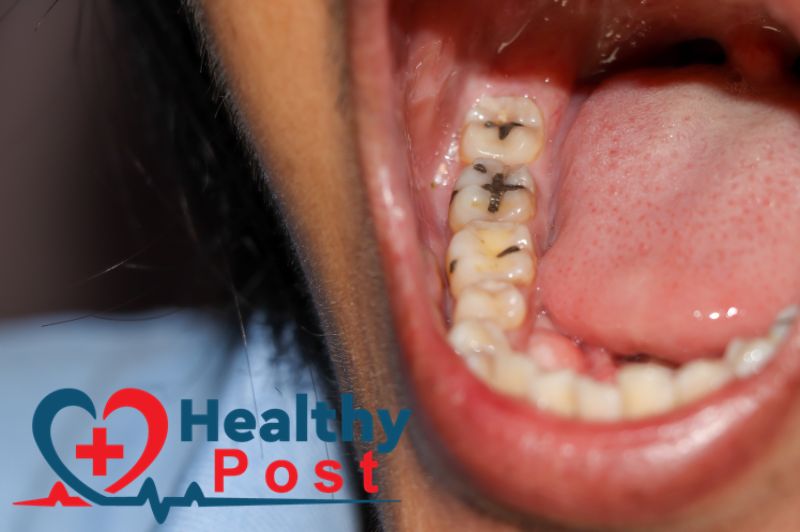Cavities often begin as small issues but can lead to severe tooth pain and even tooth loss if ignored. Emily recently faced this painful reality when a minor cavity from a past check-up turned into a severe toothache. Wondering if medication alone could fix her pain, she sought answers. Dr. John Smith from the Stomatological Clinic explains how cavities progress from minor damage to severe pain and possible tooth extraction, highlighting the need for prompt dental care.
The Stages of Cavities
1. Shallow Cavities: “Shallow cavities often don’t cause any pain, but you might notice small black spots on your teeth.”
Step 1: In the beginning, cavities only destroy the outermost layer of the tooth, which is called shallow cavities. It usually does not cause tooth pain. If you observe carefully, you can see black changes on the surface of the tooth.
2. Middle Cavities: “Do you feel pain when you encounter hot, cold, sour or sweet stimulation? – You said it doesn’t matter, it doesn’t hurt much.”
Step 2: When it reaches the intermediate cavities stage, the teeth will feel sore and painful when encountering hot, cold, sour, or sweet stimuli. The lesions have reached the shallow and middle layers of the dentin and are sensitive to sour and sweet foods. At this time, timely medical treatment can be sought, and the continued development of cavities can be effectively blocked through what is commonly known as “filling,” and the soreness and discomfort will improve as the problem is solved.
3. Deep Cavities: “When you can’t eat, you might think: ‘It’s okay, I can use the other side of my mouth.”
Step 3: The damage is getting deeper and deeper, cavities have formed on the teeth, the pain will become more and more obvious and frequent, it is impossible to bite things or food has been embedded in the cavities, and the teeth are sensitive to cold and heat. When the stimulus is removed, the pain disappears, and there is no spontaneous pain. At this time, we need to remove the decay to the deep layer of the dentin, use pulp protectors to protect the pulp, and then fill it.
4. Acute Pulpitis: “When you stayed up all night last night and your blood pressure rose due to the pain, you said: Take a painkiller and bear it.”
Step 4: At this time, the lesion has invaded the pulp tissue, producing inflammatory exudate, thus forming high pressure in the pulp cavity and causing severe pain. At this time, opening the pulp cavity drainage is the most effective way to relieve the pain of acute pulpitis.
5. Acute Periapical Periodontitis: “When your face is swollen like a meat dumpling and you can’t even open your eyes, you say: It’s no big deal, just take some anti-inflammatory drugs and it will be fine.”
Step 5: Acute periapical periodontitis infection may cause interstitial infection, which may even be life-threatening in severe cases. At this time, you need to go to a regular hospital to treat the affected tooth in time, supplemented with systemic drug treatment, and abscess incision and drainage if necessary.
6. Residual Root and Crown: “When you find that only a little crown is left of the tooth, you regretfully say: Let it be, maybe there is no other way.”
Step 6: With current medical technology, post-crown restoration can preserve the residual crown and root to the maximum extent after root canal treatment. If necessary, micro-root canal treatment can be used to achieve the effect of preserving the affected tooth as much as possible.
7. Separation and Death: “When the dentist tells you that the tooth must be extracted, you get anxious: What should I do if the tooth is gone?”
Step 7: At this time, the dentist can only comfort you, “Don’t be afraid. Three months after the tooth extraction, you can choose three ways to replace your teeth: porcelain crowns, removable dentures, and dental implants, which can fully meet your different needs.”
After repeated pain and without effective treatment, the tooth will be damaged by cavities, and tooth tissue will become more and more destroyed, eventually leading to a situation where the originally intact tooth is damaged to the point where there is little left. If you want to save it at this time, you will find that it is already too late, and the tooth can only be extracted.
How to Prevent Cavities
1. Brush Your Teeth Twice Daily
Use fluoride toothpaste and a soft-bristled toothbrush. Brush for at least two minutes, focusing on all surfaces of your teeth.
2. Floss Daily
Flossing removes food particles and plaque between teeth that your toothbrush can’t reach.
3. Limit Sugary Foods and Drinks
Reduce your intake of sugary snacks, sodas, and sticky foods. Replace sugary snacks with fruits and vegetables.
4. Visit the Dentist Regularly
Schedule dental check-ups every six months for professional cleanings and early detection of potential issues.
5. Use Mouthwash
An antimicrobial mouthwash can help reduce plaque and prevent cavities.
6. Stay Hydrated
Drink plenty of water throughout the day to flush out food particles and bacteria.
7. Chew Sugar-Free Gum
Chewing gum activates saliva production, which helps remove acids and wash away food particles.
Conclusion
Doctors remind us that due to the particularity of the tooth’s own structure, the damage that occurs to the teeth is usually irreversible. Once damaged, it cannot recover on its own. Therefore, we need to pay attention to the pain and discomfort of the teeth, try not to delay, and seek medical treatment in time. Prevention and timely care are key to maintaining a healthy smile.


